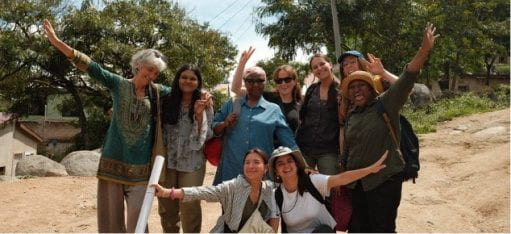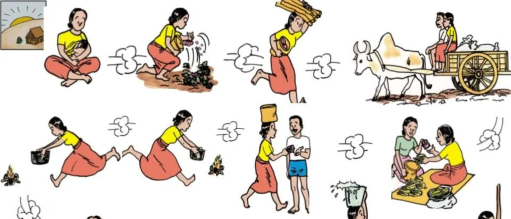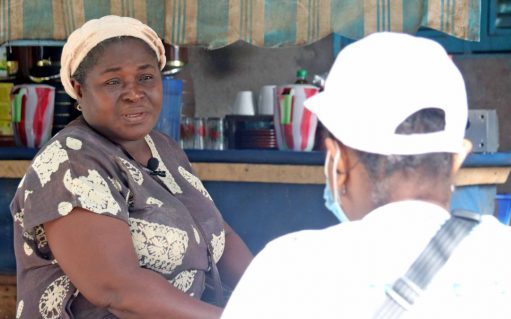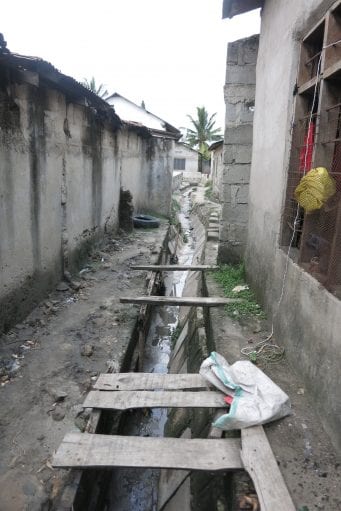Beyond the mango tree: An exploration and reflection on women, care and sanitation in Kigoto
By Dana Sousa-Limbu, on 20 September 2023
A blog written by Annabel Collinson, 2022-23 student of the Environment and Sustainable Development MSc
“My house is just beyond the mango tree”
Naomi* explained, the stream gurgling quietly behind us. My hand, covered in a thin layer of dirt and sweat, added blotches to the page as I wrote furiously. After a long first day in the field we stumbled upon Naomi, washing clothes in the stream on an increasingly warm day. In the heat of the afternoon we felt overwhelmed by the prospect of another interview, but we knew we needed to speak to her; we promised we’d return. The next day, as we began our ascent into the hills of Kigoto, her house seemed to creep further and further away. Her house was behind the mango tree, sure, but far, far behind. We hiked almost vertically up a precarious hill, jumping over gaps in rocks and sliding over boulders. We grew more tired with each step we took, but the warm breeze behind us and the music coming from the homes we passed made our journey joyous. When we reached Naomi she was sitting with her nine children at the top of the hill next to her home. She helped lay out a blanket for us, her now very pregnant belly getting in the way as she tried to bend over to smooth out its woven edges. Breathless, she pulled herself up to perch on a nearby rock. We clambered onto the rug. It felt like I was five again, joining story time at the local library. As I turned to look behind me, the sea stretched out wide; islands peppered the ocean and clouds dotted the sky. The hill on which Naomi’s house was positioned dropped off almost directly beneath me—she was easily at the highest elevation of any of our participants.
All our interviews in Kigoto took almost an hour and half, including a time use survey to outline each woman’s day. Naomi’s day was by far one of the most strenuous.Without a husband and little help from other family members, Naomi is simultaneously consumed by childcare and her work as a clothes washer. The stream where we first met Naomi is where she spends most of her days, washing clothes and collecting water. Her trek to the stream devours a large part of her week; five times a day she climbs up and down the hill, carrying water back for bathing and cleaning clothes. This hike used to only take a few minutes a day, but Naomi is pregnant with her tenth child. These commutes now take almost forty minutes round trip. Her family’s clothes are washed once a week at best, once a month at worst.
Our team’s research sought to understand women’s everyday experiences as they pertained to time, labor and care. We hypothesized, initially, that improved access to sanitation would improve women’s mental and physical wellbeing. We knew that they were burdened with the majority of care work and that the taboos within the community, compounded by social norms and gender roles, created an intense environment which diminished opportunities for capacity building.

Students and research project partners on a boat trip in Tanzania
After an incredibly gruelling second day of interviews our team sat around a table, time use surveys spread out before us, swimming in an ocean of data and information. We were determined not to lose sight of these women and their stories, to make sure they remained at the forefront of our work. I poured over the surveys and the research, examining each one to understand underlying patterns of behavior and circumstance.We met women with no access to water or a connection via MWAUWASA, a pit latrine or an indoor toilet, a one-room home or a three-bedroom home. As I continued to scour the data I was constantly reminded of Joy.
When we met Joy we were sure we were meeting a woman in the best circumstances. She had five bedrooms in her home—so many she admitted she couldn’t use them all. She had help taking care of her children and she had both a working indoor toilet and an outdoor toilet.My assumption, at least, was that she would be the perfect example of the positive impact of improved sanitation. When we sat down with her and she shared her experience with us, however, what became undeniably clear was that her wellbeing was only partially impacted.The transformation I had been naively anticipating wasn’t there. Joy’s days were monopolized by childcare but, more importantly, she was completely isolated from anyone in the community. She wasn’t living in Kigoto out of want but rather out of necessity, and she didn’t feel connected to a community or network of other women.
Joy’s issue wasn’t sanitation—a practical need that could, with time, be fixed—but rather a feeling. Joy was incredibly lonely, and she wasn’t the only one. Time and again, no matter the circumstance, the women we spoke to were isolated and alone. In a quantitative analysis of our data Naomi and Joy could not be more dissimilar, but, through an emotional lens, their stories were incredibly alike. It was evident that, as emotional political ecology indicates, political conflicts are emotion alone; the subjectivities are contextual, but the output is the same (González-Hidalgoet al, 237). The personal is political (Crow,113). In both instances Joy and Naomi were at odds with their circumstances and without control, forced to extend themselves to accommodate for the lack of support they received. Emotional political ecology would contend that this emotional labor is to be anticipated.
Sitting at the table I concluded that, no matter what demographics we chose or what circumstances we focused on, we would continue to find women who felt hopeless and lonely, resigned to believe they were not capable of achieving better conditions. These were women with wishes and ambitions, who in many instances wanted more but felt that it just wasn’t possible. In some cases, it would be difficult to dramatically improve their situation but, for many of these women, the variable that could drastically change their lives was community.
At the intersection of pragmatic and strategic needs was the need for a network of women, a place to engage with the community and find opportunities for growth and change. Our multi-pronged solution, comprised of the introduction of female-focused, female run “care hubs,” the encouragement of increased resources for women and inclusion of their voices at every level of decision-making, and the enforcement of cluster household improvements, highlights the need to support women on multiple scales and underlines the necessity for intersectional spaces. In the case of the care hub, the women we spoke to were adamant that they wanted a space in which they could “relax and feel comfortable.” With a focus on systems of care, our solutions demand space for women and carers within infrastructure. It acknowledges that the production of infrastructure has, thus far, been disjointed and unsupportive. Underlining the methodology set out by Donna Haraway, our propositions seek to position women to create and establish knowledge, to encourage the “persistence of their vision” (Haraway, 581).
Using both emotional political ecology and feminist political ecology our solutions renegotiate the everyday, reimagining what the community could look like if it were centered around intersectional knowledge production. In this way, these ideals have the power to support meaning-making and solution- creation at both the practical and strategic level.
Each woman we spoke to unraveled a hypothesis, challenged a prediction and reconfigured an observation. We left each interview feeling rich with knowledge, and their stories have shaped our recommendations for the better. After almost every interview we invited each woman to our focus group or our final meeting with local officials. I was convinced only a handful would show, now knowing how busy and difficult their daily schedules were and how exhausted they must be. On the day of our focus group, in a small church hall hung with colorful drapes and lined with plastic chairs, in walked almost every woman we invited, eager to share and support our work. Our focus group was fruitful and vibrant, filled with poignant remarks and effervescent conversation. On the final day, knowing how far each woman had to travel, I would not have anticipated that every one of the five women we invited would have joined. I felt so grateful that they believed in our work enough to attend and that they felt comfortable with us to let us share their experiences.
Arguing for a community of care to support the needs of women in Kigoto and beyond was difficult, and we knew that our attempt to shift the narrative around women’s needs would be challenging. Feminist political ecology acknowledges the need to focus on the everyday, and emotional political ecology notes the critical gap between the emotional and the political; both of these issues, as we saw in Kigoto, shape and impact the burden of care on women (González-Hidalgo et al, 250). Critical knowledge can only be gained and supported through community; our research helped us understand the power of storytelling and the value of community for women in Kigoto. Through our insights and recommendations, we hope to empower and embolden the women of Kigoto to see themselves as part of a powerful collective and to use this power to seek opportunity and call for change.
*Names have been changed to maintain confidentiality.

Students, staff and research partners from the Environment and Sustainable Development overseas practice engagement in Tanzania
Listen to the ‘Tanzania 2023’ playlist by Annabel on Spotify.
References
Crow, B.A. (2000). Radical feminism a documentary reader. New York New York University Press.
González-Hidalgo, M. and Zografos, C. (2019). Emotions, power, and environmental conflict: Expanding the ‘emotional turn’ in political ecology. Progress in Human Geography, [online] p.030913251882464. doi:https://doi.org/10.1177/0309132518824644.
Haraway, D. (1988). Situated Knowledges: the Science Question in Feminism and the Privilege of Partial Perspective. Feminist Studies, [online] 14(3), pp.575–599. Available at: https://www.jstor.org/stable/3178066
 Close
Close


































